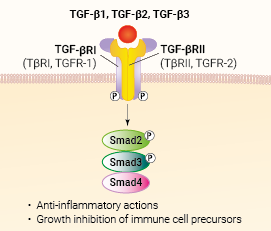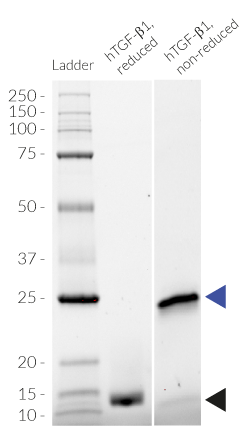Recombinant human TGF-β1 protein - Bioactive cytokine
| Product | Unit size | Cat. code | Docs. | Qty. | Price | |
|---|---|---|---|---|---|---|
|
Recombinant human TGF-β1 Recombinant Cytokine, source: HEK293 |
Show product |
10 µg 5 x 10 µg |
rcyc-htgfb1
|
|
Human TGF-β1 - Mammalian cell-expressed, tag-free, with HSA
Recombinant TGF-β1 is a high-quality and biologically active cytokine, validated using proprietary TGF-β reporter cells. This TGF-β isoform is produced in HEK293 cells to ensure protein glycosylation and bona fide 3D structure.
Recombinant human TGF-β1 can be used together with HEK-Blue™ TGF-β cells for the screening of inhibitory molecules, such as Fresolimumab, a monoclonal antibody targeting all isoforms of TGF-β (see figures).

TGF-β signaling and biological functions
InvivoGen also offers:
Key features
- Each lot is validated using HEK-Blue™ TGF-β cells
- Endotoxin < 0.1 EU/µg
- 0.2 µm sterile-filtered
Applications
- TGF-β detection and quantification assays (positive control)
- Screening and release assays for antibodies blocking TGF-β signaling
- Screening and release assays for engineered TGF-β proteins
Transforming growth factor-beta (TGF-β), also known as tumor growth factor-beta, is a secreted cytokine that regulates numerous cellular functions, such as cell proliferation, apoptosis, differentiation, and migration.
InvivoGen’s products are for research use only, and not for clinical or veterinary use.
Back to the topSpecifications
Source: HEK293 cells
Species: Human
Alternative name: Transforming growth factor beta-1
Carrier: HSA (human serum albumin)
Tag: Tag-free
Accession number: P01137
Molecular weight: ~ 25 kDa (SDS PAGE, non-reducing conditions)
Solubility: 100 μg/ml in water
Formulation: Phosphate buffer saline (pH 7.4), 5% saccharose, 2% HSA
Sterility: 0.2 µm filtration
Form: Lyophilized
Reconstitution buffer: Endotoxin-free water (provided)
Purity: ≥95% (SDS-PAGE)
Endotoxin level: ≤ 0.1 EU/μg (measurement by kinetic chromogenic LAL assay)
Tested applications: Cellular assays
Quality control: Each lot is functionally tested and validated
Back to the topContents
Recombinant human TGF-β1 is provided as a lyophilized powder and is available in two quantities:
- rcyc-htgfb1: 10 μg
- rcyc-htgfb1-5: 50 μg (5 x 10 μg)
- 1.5 ml endotoxin-free water for rcyc-htgfb1 and rcyc-htgfb1-5
![]() Recombinant human TGF-β1 is shipped at room temperature.
Recombinant human TGF-β1 is shipped at room temperature.
![]() Upon receipt, the product should be stored at -20°C.
Upon receipt, the product should be stored at -20°C.
![]() Avoid repeated freeze-thaw cycles.
Avoid repeated freeze-thaw cycles.
Details
Tumor growth factor-beta (TGF-β) belongs to a family of structurally related cytokines that regulate a plethora of cellular functions, such as proliferation, apoptosis, differentiation, and migration [1,2]. TGF-β exists in at least three isoforms; TGF-β1, TGF-β2, and TGF-β3. In the immune system, TGF-β1 is the predominant isoform [1]. It is produced by many cell types, including macrophages, in a latent form that is bound to two other polypeptides, latent TGF-β1 binding protein (LTBP) and latency-associated peptide (LAP). Upon cleavage of these proproteins, the mature TGF-β1 is released. This mature protein can bind its cell surface receptors and initiate signaling.
TGF-β binds to type II receptors (TβR-II) which recruit and activate type I receptors (TβR-I). The active ligand-heterotetrameric receptor complex signals through downstream transcriptional factors named Smads, including Smad2, Smad3, and Smad4.
Smad complexes translocate into the nucleus where they regulate the transcription of target genes, which contain one or more Smad binding elements (SBEs) in their promoter region [3]. Perturbations in TGF-β signaling affect immune homeostasis and tolerance, leading to inflammatory diseases and tumor immune evasion [3].
1. Travis MA. & Sheppard D., 2014. TGF-β activation and function in immunity. Annu Rev Immunol. 32:51-82.
2. Taylor AW., 2009. Review of the activation of TGF-beta in immunity. J Leukoc Biol. 85(1):29-33.
3. Battle E. & Massagué J., 2019. Transforming Growth Factor-beta Signaling in Immunity and Cancer. Immunity. 50(4):924.










